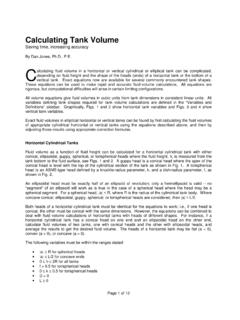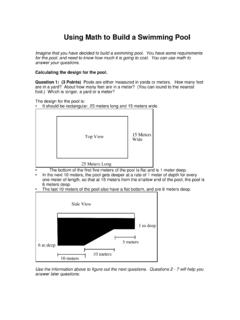Transcription of Criteria for Detention Facility Design - New York City
1 0 Criteria for Detention Facility Design Criteria FOR Detention Facility Design Bureau of Water & Sewer Operations Revised November 19, 2012 For more information contact: 718-595-4325 or Contents Criteria .. 1 I. Detention Facilities with a variable outflow .. 3 II. Detention Facilities within an approximately constant outflow .. 4 III. Weighted effective runoff coefficient for series Detention systems .. 5 IV. Maximum storage depth with an orifice tube outlet .. 6 General .. 8 Example 9 Example Example Example Stormflow Calculations ..13 Sample 1 ..14 Sample 2 ..15 1 Criteria for Detention Facility Design Criteria The following procedure is to be used to compute the total site developed storm flow in cubic feet per second (cfs), QDEV , the Allowable Flow in cfs, QALL , the Detention Facility maximum release rate in cfs, QDRR , the required Detention Facility volume in cubic feet (ft3), VR , and the Detention Facility maximum storage depth in feet, (ft.)
2 , SD . It is used for house connection proposals and site connection proposals, for storm flow generated totally within the site, to be detained within the site, and not receiving any street flow. The Detention Facility is designed to provide the maximum volume required for the storm with a 10 year (yr.) return frequency. Porous open bottom Detention facilities must be located a minimum of 3 ft. above the ground water table to prevent possible ground water infiltration into the sewer system and 10 ft. minimum (and/or per Construction Code) away from Building Foundation. The use of open bottom Detention facilities requires the submission of boring logs to establish ground water levels and soil permeability when infiltration credit is applicable. The method described below is based on an article entitled," A simple method of retention basin Design ", by Glen Yrjanainen and Alan W. Warren, which appeared in Water and Sewage Works, December 1973, and "Storm Water Detention for Drainage, Water Quality, and CSO Management", by Peter Stahre and Ben Urbonas, published by Prentice Hall, 1990.
3 Detention storage volume is computed by calculating the difference between the inflow and outflow hydrographs, by the basic equation: where: VR = the required Detention storage volume in ft3 t0 = the beginning of the time of storage in minutes (min.) t = the total time that storage is required in min. QIN = the average inflow rate to the Facility in cfs QOUT = the average outflow rate from the Facility in cfs t VR= t0 (QIN QOUT) 60 dt 2 Criteria for Detention Facility Design The average inflow rate in cfs is computed based on the, Rational Method , by the equation: QIN = CWTiAT where: QIN = the average inflow rate in cfs during the rainfall event CWT = the weighted runoff coefficient for the tributary area i = the average rainfall intensity in inches per hour (in/hr) for the event AT = the area tributary to the Detention Facility in acres (ac.)
4 The weighted runoff coefficient for an area tributary to a Detention Facility is computed by the equation: CWT = (C1A1 + C2A2 +..etc.)/ At where: CWT = the weighted runoff coefficient for the tributary area C1 = the runoff coefficient for the area classified as roof A1 = the area classified as roof in square feet (ft2) C2 = the runoff coefficient for the area classified as paved A2 = the area classified as paved in ft2 At = the area tributary to the Detention Facility in ft2 The average rainfall intensity in in/hr, i, is computed for the storm with a 10 yr. return frequency by the equation: i10 = 140/(t + 15) where: i10 = the average rainfall intensity in in/hr for the storm with a 10 yr. return frequency t = the duration of a rainfall event in min. for the storm with a 10 yr. return frequency The Rational Method , assumes a uniform block rainfall distribution over the entire tributary area for the duration of the rainfall event, that the runoff hydrograph has the same shape with respect to time as the rainfall hyetograph, and that the use of a weighted runoff coefficient for the tributary area is valid.
5 For urban areas of 400 ac. or less these assumptions are appropriate. Under the new rule for stormwater management for discharge to a combined sewer system the maximum release rate in cfs, QRR, to which the site stormwater flow rate to the combined sewer will be restricted shall be the greater of cfs or 10% of the Allowable Flow. If the Allowable Flow is less than cfs, the site stormwater release rate to the combined sewer shall be the Allowable Flow. For discharge to a separate storm sewer system the maximum release rate in cfs, QRR, to which the site stormwater flow rate to the storm sewer will be restricted will be the Allowable Flow. The Allowable Flow in cfs, QALL , is computed in accordance with the, Rational Method , by the equation: 3 Criteria for Detention Facility Design QALL = CDPiDP ADP/43,560 where: QALL = the Allowable Flow rate in cfs CDP = the runoff coefficient for the site, from the drainage plan iDP = the most upstream rainfall intensity in in/hr, from the drainage plan ADP = the area of the site tributary to the sewer in ft2, as per the drainage plan The maximum release rate in cfs from a Detention Facility , QDRR, is not always the same as the maximum release rate in cfs to which the site stormwater flow rate will be restricted, QRR.
6 In cases where a Detention Facility discharges to another Facility in series, the maximum release rate from the upstream Facility may be greater than the Allowable Flow and or the maximum release rate from the site, QRR. The maximum release rate in cfs from a Detention Facility which is connected to a sewer, QDRR, will depend on whether the connection is to a combined sewer or to a separate storm sewer, the number of connections proposed, if any stormwater flow will be discharged unrestricted, if any constant and continuous stormwater recycling and reuse is proposed, or if any infiltration credit is proposed. Constant and continuous stormwater recycling and reuse and infiltration credit reduce the required Detention volume , but do not increase the maximum release rate to the sewer system, QRR. For a site where the total site stormwater discharges through a connection with no unrestricted discharge the maximum release rate from the Detention Facility , QDRR, will be equal to the maximum stormwater release rate from the site, QRR.
7 I. Detention Facilities with a variable outflow For a Detention Facility where the outflow is controlled by means of an outlet orifice tube, subject to a head which increases as the depth of storage increases, in a storage Facility with an approximately uniform area with respect to storage height, and for roof Detention by means of controlled flow roof drains, the average flow rate out of the Detention Facility is approximately 2/3 of the maximum outflow rate. The following procedure is used to compute the maximum required Detention storage volume in ft3: 1. Compute the duration of the storm in minutes with a 10 yr. return frequency, tV, which requires the maximum Detention volume with outflow controlled by an orifice or by controlled flow roof drains, by the equation: tV = (CWT At /QDRR) 15 where: tV = the duration of the storm in min. with a 10 yr. return frequency requiring the maximum Detention volume with a variable outflow CWT = the weighted runoff coefficient for the area tributary to the Detention Facility At = the area tributary to the Detention Facility in ft2 QDRR = the Detention Facility maximum release rate in cfs 4 Criteria for Detention Facility Design 2.
8 Compute the maximum required Detention volume in ft3 with outflow controlled by an orifice tube or by controlled flow roof drains, VV, by the equation: 3. For roof Detention compute the duration of the storm in minutes with a 10 yr. return frequency, tV, which requires the maximum Detention volume , and compute the maximum required Detention volume in ft3 with outflow controlled by controlled flow roof drains, VV, with a Detention Facility maximum release rate in cfs, QDRR, as in I-1 through I-2 above. Confirm that the Detention volume provided on the controlled flow roof, based on the slopes and geometry of the roof, is equal to or greater than the volume required, VV, and that the actual release rate from the roof does not exceed the proposed maximum release rate in cfs for the roof, QDRR, following the procedure detailed in the DEP Guidelines for the Design and Construction of Stormwater Management Systems.
9 II. Detention Facilities within an approximately constant outflow For a Detention Facility where the outflow is approximately constant, as by the use of a pump characterized by a steep curve operating over a narrow head range, or by the use of an orifice tube subject to an approximately constant head, the average flow rate out of the Detention Facility is approximately 95% of the maximum outflow rate. The following procedure is used to compute the required Detention storage volume in ft3. 1. Compute the duration of the storm in min. with a 10 yr. return frequency, tC, which requires the maximum Detention volume with an approximately constant outflow, by the equation: tC = (CWT At /QDRR) 15 where: tC = the duration of the storm in min., with a 10 yr. return frequency, requiring the maximum Detention volume with an approximately constant outflow CWT = the weighted runoff coefficient for the area tributary to the Detention Facility At = the area tributary to the Detention Facility in ft2 QDRR = the Detention Facility maximum release rate in cfs VV = [ /(tV + 15) 40 QDRR] tV where: VV = the maximum required Detention volume in ft3 with a variable outflow CWT = the weighted runoff coefficient for the area tributary to the Detention Facility At = the area tributary to the Detention Facility in ft2 tV = the duration of the storm in min.
10 , with a 10 yr. return frequency, requiring the maximum Detention volume with a variable outflow QDRR = the Detention Facility maximum release rate in cfs 5 Criteria for Detention Facility Design 2. Compute the maximum required Detention volume in ft3 with an approximately constant outflow, VC, by the equation: VC = [ At /(tC + 15) 57 QDRR] tC where: VC = the maximum required Detention volume with an approximately constant outflow CWT = the weighted runoff coefficient for the area tributary to the Detention Facility At = the area tributary to the Detention Facility in ft2 tC = the duration of the storm in min., with a 10 yr. return frequency, requiring the maximum Detention volume with an approximately constant outflow QDRR = the Detention Facility maximum release rate in cfs III. Weighted effective runoff coefficient for series Detention systems 1. A. When the flow from a roof which has been restricted by controlled flow roof drains is discharged to a subsurface Detention Facility , the weighted effective weighted runoff coefficient for the roof, CWE, is based on the average rainfall intensity in in/hr, i10, for the duration in min.

















